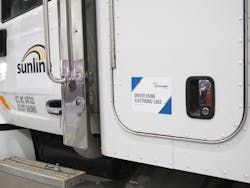David Carruth will tell you that when he switched his 55-truck LTL fleet over to electronic logs back in 2015, his intent was to make recording hours of service (HOS) information simpler and more accurate for both his full-time company drivers and contracted owner-operators.
“One of the stresses we found with paper logs is that drivers really never knew when their day was going to end,” Carruth, CEO of Canada-based ONE For Freight, told Fleet Owner.
“By moving over to electronic logs, they know exactly when their day must end and allow us to plan around that accordingly,” he said. “It holds everyone else in the company accountable to the driver’s time and puts them all on a level playing field, including the dispatcher and the technician.”
This also created a level playing field with ONE For Freight’s shippers, too, he added. It forced them to recognize—with data in hand—which lengths of haul were legal and which ones were not.
“We’re able to use the information to create value and drive the value statement with our clients,” Carruth explained.
“The client understands we have a regular shipper that ships out of Concord [Canada]. They’re consistently late. Freight isn’t ready until six, seven, eight o’clock at night, and the expectation is that it’s delivered in Bristol, NH, before noon the next day,” he said. “Well, if you’re running an electronic logging device, you can’t do that, right? It’s just not a safe practice. It’s really helped to show our clients, ‘Look, I understand it’s only 680 miles, but you can’t just run all out to get there.’”
Aside from the overall benefit of getting customers to recognize legal and potentially illegal lengths of haul, Carruth discovered his fleet was saving money in several other areas as well, thanks to electronic logs.
“For instance, just as with the fuel tax reporting, with the ELD it’s almost a push of a button, as opposed to anywhere from 10 to 20 hours of a person’s time a month to put together the package it needs,” he explained. “It’s a push of a button, as compared to anywhere from 10 to 20 hours depending on the type of filing that they’re doing. So it’s easily taking anywhere from $500 to $1,000 a month in pure cost out of your business. Then we could look at utilizing that person to do something else.”
Mike Ham, vice president and general manager of Omnitracs Canada, added that just eliminating the use of paper logbooks themselves generates a savings for fleets and drivers alike.
“Simply put, at $2 or $3 a logbook—and everybody’s carrying two or three logbooks—the cost of paper logbooks is more than the cost of automating logs with ELDs,” Ham explained, “When you look at the paper exercise today, everything rounds up to 15 minutes, when actually some of those events may be just five, six or seven minutes in length. “
He added that by more accurately noting such smaller time increments can probably save a driver from two to two and a half hours a week in paperwork versus drive time.
Now, that’s not saying that all those drive times are going to be “full,” he said. But he believes that a driver may get an additional 100 miles a week by timing such increments more accurately. “That is good for the company and good for the driver,” Ham stressed. He noted motor carriers that don’t automate the HOS data collection process “have somebody trying to do audits … and they can only audit a fraction of the fleet whereas when you go to ELDs, push a button and everybody’s got the information at all different levels, and it’s all auditable. So there’s return on investment all around ELDs.”
Pete Allen, executive vice president of sales for MiX Telematics North America, argues that if fleets adopt ELDs with more capability versus ones just geared to record on- and off-duty times merely to be in compliance with HOS rules, they could actually turn the devices into “profit centers” for trucking operations large and small alike.
“We conducted a recent survey and found that investing in a ‘fleet management solution’ instead of just a bare-bones ELD can help motor carriers reduce operating costs by $50 to $100 per vehicle, per month, after accounting for the cost of the system,” he said.
“That shows that while a bare-bones ELD is likely to cost money, a full-featured one can actually reduce a fleet’s overall operating costs,” Allen stressed. “If done right, an ELD can and should pay for itself every month.”
Part of “doing it right” is connecting ELD data to the freight transportation system as a whole—to integrate a driver’s available hours closer with the time schedules of the freight to be moved.
Scott Pagan, president and COO of Descartes Systems Group, said it is via such “integration” that fleets and drivers alike should be able to help provide more “predictive freight” information. He noted, for example, that MacroPoint, which was recently purchased by Descartes, operates a connected network of over two million trucking assets and drivers.
“They connect to trucks through integrations with ELDs and transportation management systems and/or any cell phone, whether that be through GPS-enabled smartphone applications or location-based mobile phone triangulation,” Pagan explained. “MacroPoint uses this data to help transportation brokers, logistic service providers, and shippers track the locations of deliveries and trucks. They can also use this content to provide transportation brokers and shippers with predictive freight capacity to help identify early opportunities for additional freight moves.”
Tony Lourakis, CEO of BigRoad-A Fleet Complete Company, noted a similar “predictive” capability for freight moves is what his firm is striving for through its new BigRoad Freight package, a load matching platform designed for owner-operators and small fleets of five to 20 vehicles. It features an ELD component that provides HOS visibility and a payment processing program within one system.
“The philosophy here is that we’re moving away from ‘saving money’ to ‘making money,’” he explained. “It’s not a load board in the traditional sense because it’s taking that HOS data recorded by the ELD and ‘triaging’ the freight being tendered based on a driver’s available hours—and not just hours left in a driver’s day but over whatever five-, seven-, or 14-day cycle they are working on.”
Lourakis said the system takes all that available time and then “looks” to match it up with the best loads.
“Maybe a driver only has enough hours left in a day to pick up a load before he or she needs to shut down,” he explained. “But by looking at their seven-day cycle of available hours, they can actually move that freight coast-to-coast over a three-day period. That’s when it becomes winning a $10,000 job due to available hours vs. a $2,000 job.”
Lourakis stressed that in today’s trucking world, a driver’s available time is what is really precious. So any technology that can help better maximize that time is going to deliver a money-making opportunity for small fleets.
“Every hour you run empty or sit at a dock waiting is an hour spent burning cash,” he explained. “The trick is to maximize the hours you are under load, and the only way to do that is with data collected electronically.”
“You really need ELD data to make sense of it all,” added Jim Griffin, COO and chief technology officer for Fleet Advantage. “I’ve been telling anyone who will listen not to just look at complying with the ELD mandate itself—that’s shortsighted. Take an extra step and look for systems that can leverage that data [from an ELD] for operational savings going forward. By doing that, you don’t have to buy a new device to gain those capabilities; in other words, you don’t have to buy an ELD twice.”
While many small fleets and drivers decry what many call the “intrusiveness” of collecting and reporting HOS data for all to see via ELDs, Griffin stressed that in reality trucking operators are “driving blind” if they don’t have such data close at hand on a regular basis.
“In today’s world, any business that is not making data-based decisions is not making good decisions,” he emphasized. “This industry tends to move very slowly; but in this case, the regulatory environment is causing it to pick up and push the envelope a little bit.”
And ELDs are “bringing to a head” inefficiencies in the supply chain, specifically those that drivers bear the brunt of, inefficiencies at loading docks and inefficient loading times themselves, noted Stephen Laskowski, incoming president of the Ontario Trucking Association.
“What’s happening now is that motor carriers, drivers, shippers, and 3PLs (third-party logistics companies) are having real conversations about removing those inefficiencies,” he said.
“[About] the cost of these inefficiencies, their impact on drivers, and how the supply chain needs to be adjusted to eliminate these inefficiencies, because they can simply no longer be absorbed,” Laskowski stressed.
“ELDs make things transparent for everyone and let the drivers do what they like to do the best and that’s drive [while] letting [motor carrier] management and shippers deal with making decisions based on shared and accurate information,” he said.
ELD enforcement information
Dee Davis, senior safety consultant with National Transportation Consultants Inc. and a 20-year veteran of the Indiana State Police Commercial Vehicle Enforcement Division, recently offered some ELD enforcement tips for fleets.
ELDs do not add to or change existing hours of service (HOS) rules. The basic HOS rules (barring exceptions) are that drivers may not drive more than 11 hours in a given day; drivers must complete the on-duty portion of their day in 14 hours; drivers must take a 30-minute break and must have 10 hours off-duty; and drivers cannot drive more than 60 hours in a seven-day period or 70 hours in an eight-day period.
Motor carriers must ensure their drivers carry ELD instructional and support material. That includes a user’s manual for the operation of an ELD; an instructional sheet detailing malfunction reporting requirements; an instruction sheet detailing the supported data transfer protocols so roadside inspectors can download information from the ELD; and a supply of blank paper logbooks.
Motor carriers are responsible for ELD compliance. Regardless of any contractual responsibility assumed by a driver staffing company, the motor carrier remains responsible for compliance in the eyes of the Federal Motor Carrier Safety Administration (FMCSA).
A driver must be able to manually operate an ELD. Drivers must be able to manually input or verify their power unit’s number, trail number (if applicable), and shipping number document (if applicable). They must be able to provide the correct log-in and duty status plus manually input annotations, location descriptions (when prompted), and output file comments.
A malfunctioning ELD must be repaired within eight days. And drivers with a malfunctioning ELD must be able to reconstruct their logs for the current 24-hour period and previous seven days.
Drivers will not be placed out of service for ELD violations until April 1. Drivers who aren’t using an ELD but are using paper logs will receive a citation but won’t be placed out of service until April 1, and that violation won’t count against the carrier’s Safety Measurement System score, according to FMCSA. However, on April 1, “regular enforcement” goes into effect and commercial drivers will be taken off the road for not using an ELD or “grandfathered-in” AOBRD (automatic onboard recording device). Use of AOBRDs allows for a two-year compliance extension, meaning that switching to an ELD will need to occur by December 2019.
About the Author
Sean Kilcarr
Editor in Chief
Sean Kilcarr is a former longtime FleetOwner senior editor who wrote for the publication from 2000 to 2018. He served as editor-in-chief from 2017 to 2018.



